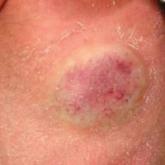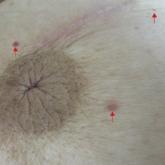Original Research

Congenital Hemangioma
Congenital hemangiomas (CHs) are fully developed hemangiomas that are present at birth. There are 2 possible types: rapidly involuting CHs (RICHs...
From the Geisinger Commonwealth School of Medicine, Scranton, Pennsylvania. Dr. Poliak also is from the Wright Center of Graduate Medical Education, Scranton, and Lehigh Valley Health Network, Children’s Clinic, Allentown, Pennsylvania.
The authors report no conflict of interest.
Correspondence: Nina Poliak, MD, MPH, 125 Birch Ave, Bala Cynwyd, PA 19004 (nxpoliak@gmail.com).

This case describes 3 different vascular malformations in the same patient. Cutis marmorata telangiectatica congenita is rare and yet is described in this patient along with 2 other notable endothelial abnormalities. The clinical interest of this case is heightened by the presence of CMTC.
The causative factor of SWS is a well-documented mutation of the GNAQ gene, but there is considerable variability in how it affects the patient. Unlike in SWS, no single factor can be attributed to the development of IH. This case shows that these 3 diseases are not mutually exclusive and can present with unusually severe features when they occur concomitantly. The embryologic basis of SWS traces its roots back to the first trimester during vascular development, where lack of regression and development of the primitive cephalic venous plexus occur.10The presence of a large IH on the patient’s philtrum that demonstrated markers of pericyte and neural crest cells illustrates that the developmental origins of one neurocutaneous disorder do not necessarily interfere with the development of other cutaneous conditions.11
The severity of the SWS in our patient was highlighted by the extensive nevus flammeus. These lesions occurred over the face, trunk, arms, and legs. The port-wine stain with dermatomal distribution of the ophthalmic nerve was the most concerning feature regarding the development of neurologic complications in this patient. Although the developmental delays associated with SWS can be serious, early intervention is important and can improve long-term outcomes. The facial IH arising at birth was contrary to the typical presentation. All of these factors will be kept in mind as the patient progresses and patient-centered care is provided. Because this patient’s presentation differed from other patients with IH, we will be more vigilant in providing close follow-up and monitoring for other medical problems involving other organs (eg, the brain); for instance, we will monitor for seizures and developmental delay.
In our patient, a unique pattern of SWS, facial IH, and CMTC are described in a pediatric patient. Many disciplines are involved in the treatment. In the patient’s first days of life, extensive collaboration between pediatrics and dermatologists was pivotal, with ophthalmology, pathology, and radiology consultations at hand. This case highlights that several vascular malformations of different origins can occur in the same patient. Epigenetic along with genetic factors likely contributed to this fascinating presentation. The importance of parental education and maintaining appropriate follow-up for this patient is crucial for a favorable outcome.

Congenital hemangiomas (CHs) are fully developed hemangiomas that are present at birth. There are 2 possible types: rapidly involuting CHs (RICHs...
RASopathies, a class of developmental disorders, are caused by mutations in genes that encode protein components of the RAS/mitogen-activated...

Atypical vascular lesions (AVLs) of the breast are rare cutaneous vascular proliferations that appear as flesh-colored or erythematous papules or...
